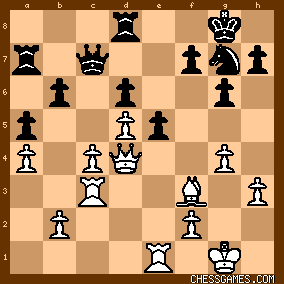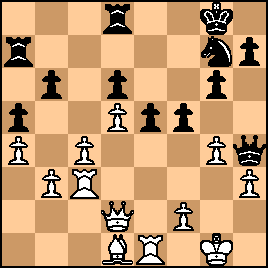KEG: Post II
18. Rac1 b6
This might have cost Pillsbury against a more polished opponent. Better chances for Black were offered by 18...Qa5 or 18...Re8. 19. Rc3
Both the Tournament Book (quoting Janowski) and Sergeant Watts claimed that von Popiel should have played 19. b4 here. Janowski reportedly said this would have led to a "strong positional advantage" for White. But after 19. b4 Re8 20. c5 dxc5 21. bxc5 Nf5 Black would be better than in the game. White could attempt a King-side attack here beginning with either 19. h4 or 19. Qd2 with h4 to follow, but that does not seem to leave White much better off than does the text. After 19. Rc3, the position was:

click for larger viewBeginning here, Pillsbury made a major push to take charge. 19... a5
"!"--(Tournament Book)
"To stop b4." (Sergeant-Watts)
20. a4
"?"--(Sergeant Watts)
20. h4 may be far more dynamic, but the text hardly looks like any sort of horrible mistake to me. It certainly had little to do with von Popiel's loss. 20... Ra7
"Preparatory to his next move, which gives him the superior game." (Sergeant-Watts). Pillsbury's next move, as Sergeant-Watts seems to recognize, only gave him the better game because of von Popiel's poor play thereafter. 21. g4
21. b3 or 21. Qd2 may have been more prudent, but the text was a reasonable fighting effort by von Popiel. 21... e5?!
"!"--(Sergeant-Watts)
This worked beautifully given von Popiel's response. But objectively it was hazardous, and 21...Qc5 or 21...Re8 were better. The position after 21...e5 was:

click for larger view22. Qd2?
"?"--(Tournament Book)(Sergeant-Watts)
As all commentators agree, von Popiel should have played 22. dxe6 e.p. here. But the Tournament Book's contention that after the text Pillsbury had a "clearly superior position" is an overstatement. 22... f5!

click for larger viewIt is remarkable how Pillsbury had managed to transform his position in just a few moves. 23. b3 Qe7
24. Bd1 Qh4
This worked better for Pillsbury than it probably should have. On the face of the position, 24...Rf8 or 24...f4 appear better But by this point von Popiel seems to have become shell-shocked. At the moment, however, von Popiel was not in such awful shape. 
click for larger viewFrom here, however, it all went downhill for von Popiel. | 




